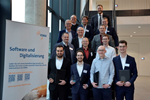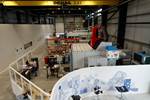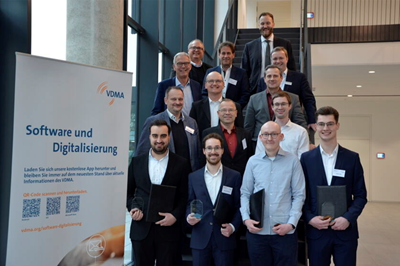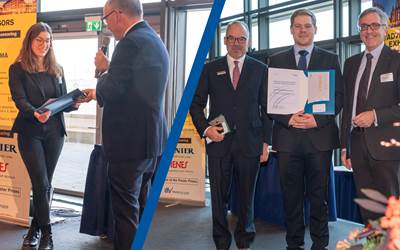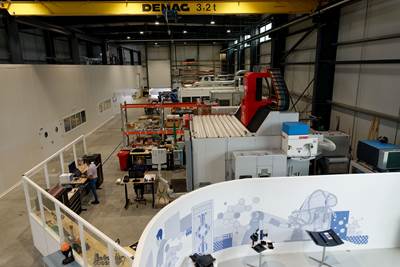ITA, Micor GmbH study the potential of in-line infrared drying of glass fiber
Research has shown that, beyond reducing energy consumption and production waste, an integrated, compact infrared module enables uniform sizing distribution on the glass fibers and more efficient production overall.
Share
Read Next
Glass fiber spinning setup and location of the integrated IR radiator. Source | The Institut für Textiltechnik (ITA)
The (ITA) of RWTH Aachen University (Germany), in collaboration with the industrial partner Micor GmbH (Niedernhausen), is developing an innovative technology for the inline drying of glass fibers. The goal is to replace traditionally energy- and time-intensive drying of glass fiber rovings with a compact infrared module integrated directly into the spinning and winding process. This approach promises significant energy savings and a notable improvement in product quality.
In conventional glass fiber production, a sizing — a water-based mixture of film formers, adhesion promoters and additives — is applied to the fibers after drawing. This sizing typically contains more than 90% water, which must be removed using prolonged drying in convection or high-frequency ovens. This leads to multiple challenges: on one hand, residual moisture during winding causes the sizing to migrate from the core of the spool to the outer layers, resulting in concentration variations of up to 400%. On the other hand, the drying process is both time- and energy-intensive, as the water must diffuse through the entire spool. If drying occurs too rapidly, high vapor pressure can build up inside the spool, potentially damaging the fibers. According to recent studies, approximately 45% of the downstream energy demand in glass fiber production is attributed solely to fiber drying.
Downstream energy demand for glass fiber production. Source | PwC, “Life Cycle Assessment of Continuous Filament Glass Fibre Products – Sustainable Performance and Strategy”
The ITA’s in-line drying technology addresses this bottleneck. A high-frequency infrared (HF-IR) emitter is integrated directly into the winding process. With a peak emission wavelength of around 1,300 nanometers, the emitter selectively heats the glass fibers and applied sizing — without significantly warming the surrounding humid air. The result is uniform and rapid drying of the fibers before they are fully wound. A sensor-controlled inline moisture measurement system regulates emitter output to ensure consistently optimal drying conditions, regardless of the growing spool diameter.
The project focuses on both polymer-based and starch-based sizings. In preliminary trials, residual moisture of less than 2% was achieved for polymer sizings, even at industrial take-off speeds of up to 1,200 meters/minute. Significant moisture reduction was also achieved for starch sizings. Scanning electron microscopy (SEM) and atomic force microscopy (AFM) confirmed uniform layer formation. In mechanical pull-out tests, the inline-dried fibers demonstrated adhesion properties in the polymer matrix that were comparable to conventionally dried fibers, taking standard deviation into consideration.
Residual moisture and interfacial shear strength from preliminary trials with polymer-based sizings. Source | The Institut für Textiltechnik (ITA)
The project aims to enable complete drying below 0.8% residual moisture. To this end, the infrared absorption capability of the sizing is being specifically enhanced, and the IR drying unit is being further optimized for installation on the glass fiber winder. The potential for savings is considerable: energy consumption can be reduced by around 20%, and sizing migration-related waste can be cut by up to 90%. At the same time, the inline drying process accelerates the entire production line by eliminating the conventional drying step, which can take up to 6 hours. Additionally, the required floor space in the production environment is minimized, as large-scale convection ovens can potentially be eliminated entirely.
Building on these results, ITA and Micor are currently developing a modular drying unit designed for integration into industrial glass fiber processes. In parallel, a specially adapted sizing formulation is being developed to maximize IR absorption and enhance drying performance. The goal is to scale the technology to industrial applications and modernize existing production lines, offering wide applicability across the industry.
Related Content
Reinforcing hollow, 3D printed parts with continuous fiber composites
Spanish startup Reinforce3D’s continuous fiber injection process (CFIP) involves injection of fibers and liquid resin into hollow parts made from any material. Potential applications include sporting goods, aerospace and automotive components, and more.
Read MoreCarbon fiber, bionic design achieve peak performance in race-ready production vehicle
Porsche worked with Action Composites to design and manufacture an innovative carbon fiber safety cage option to lightweight one of its series race vehicles, built in a one-shot compression molding process.
Read MoreBladder-assisted compression molding derivative produces complex, autoclave-quality automotive parts
HP Composites’ AirPower technology enables high-rate CFRP roof production with 50% energy savings for the Maserati MC20.
Read MorePlant tour: Airbus, Illescas, Spain
Airbus’ Illescas facility, featuring highly automated composites processes for the A350 lower wing cover and one-piece Section 19 fuselage barrels, works toward production ramp-ups and next-generation aircraft.
Read MoreRead Next
ITA graduate develops AI-supported monitoring system to detect damaged carbon fiber
Deniz Sinan Yesilyurt wins a Young Talent Award from VDMA for his Bachelor’s thesis that used machine learning to recognize various fiber defects with up to 99% accuracy during thermal stabilization.
Read MoreITA student research progresses ultra-thin composites, textile sorting
Novel method for fiber-to-fiber recycling of used textiles and a low-cost, cost-effective precursor for carbon fiber manufacture earn 2023 Walter Reiners Foundation Awards.
Read MorePlant tour: Daher Shap’in TechCenter and composites production plant, Saint-Aignan-de-Grandlieu, France
Co-located R&D and production advance OOA thermosets, thermoplastics, welding, recycling and digital technologies for faster processing and certification of lighter, more sustainable composites.
Read More